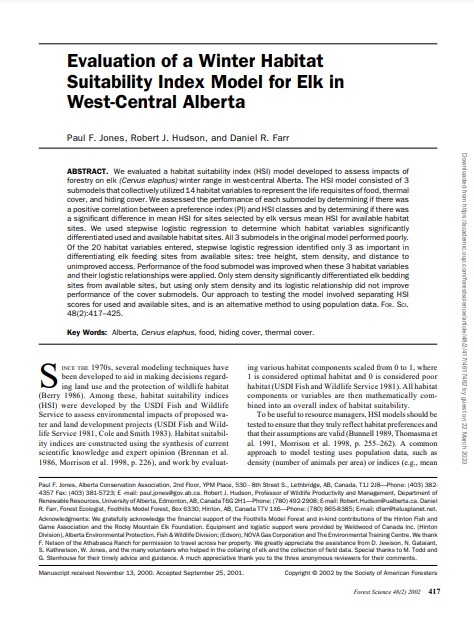Evaluation of a winter habitat suitability index model for elk in west-central Alberta
Bosque Modelo:
Foothills
Temática:
Desarrollo humano
Tipo de documento:
Artículo científico
Resumen
We evaluated a habitat suitability index (HSI) model developed to assess impacts of forestry on elk (Cervus elaphus) winter range in west-central Alberta. The HSI model consisted of 3 submodels that collectively utilized 14 habitat variables to represent the life requisites of food, thermal cover, and hiding cover. We assessed the performance of each submodel by determining if there was a positive correlation between a preference index (PI) and HSI classes and by determining if there was a significant difference in mean HSI for sites selected by elk versus mean HSI for available habitat sites. We used stepwise logistic regression to determine which habitat variables significantly differentiated used and available habitat sites. All 3 submodels in the original model performed poorly. Of the 20 habitat variables entered, stepwise logistic regression identified only 3 as important in differentiating elk feeding sites from available sites: tree height, stem density, and distance to unimproved access. Performance of the food submodel was improved when these 3 habitat variables and their logistic relationships were applied. Only stem density significantly differentiated elk bedding sites from available sites, but using only stem density and its logistic relationship did not improve performance of the cover submodels. Our approach to testing the model involved separating HSI scores for used and available sites, and is an alternative method to using population data.
Información Bibliográfica
Autor:
Jones, PF, RJ Hudson and DR Farr.
Revista:
Forest Science
Año:
2002
N°:
2
País :
Canadá
Páginas:
417 - 425
Volumen:
48
Idioma:
Ingles
Palabras claves
Alberta, Cervus elaphus, food, hiding cover, thermal cover.





